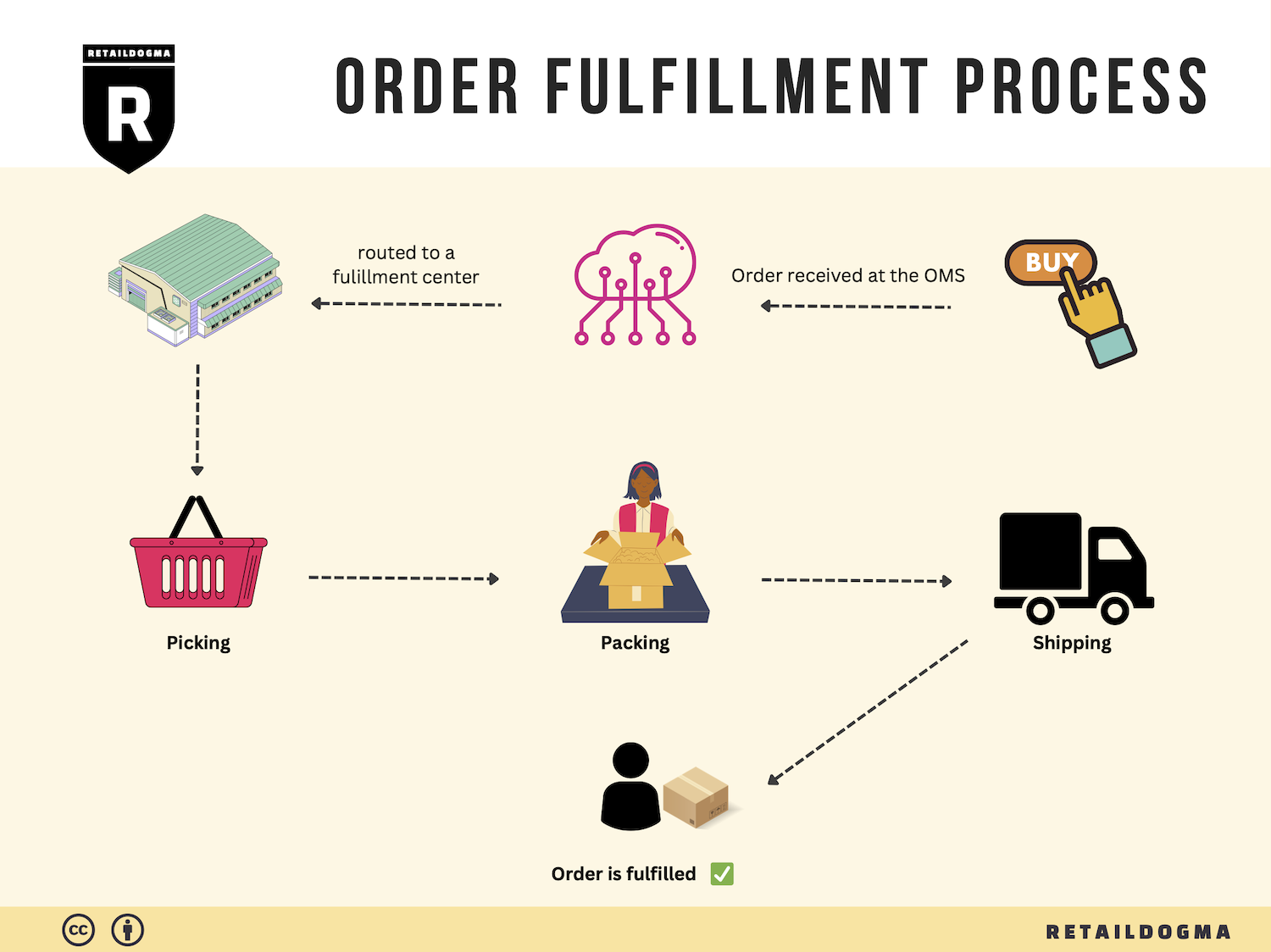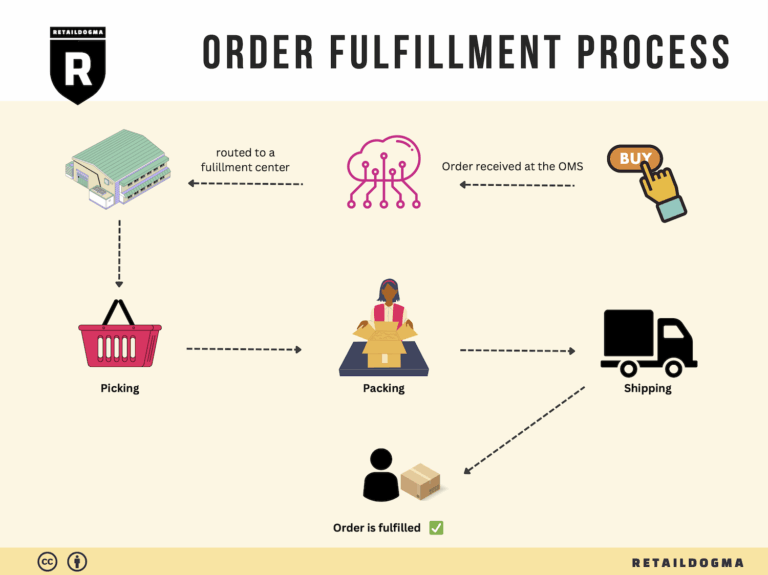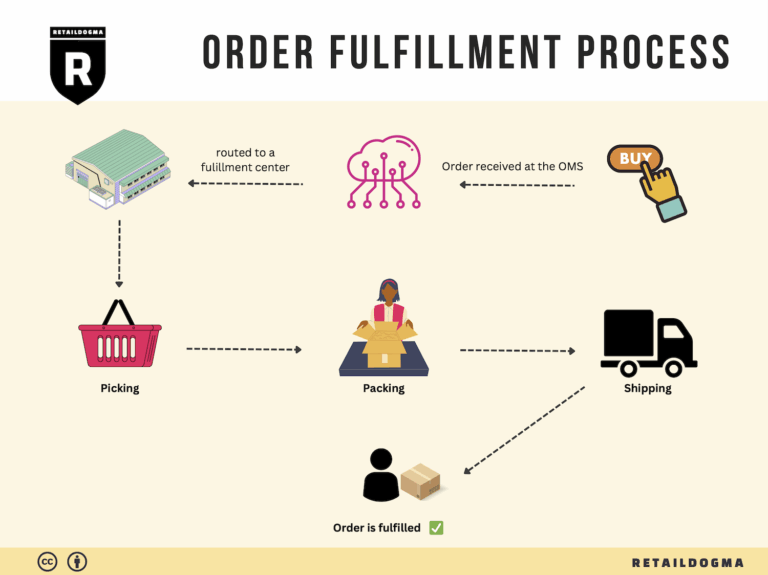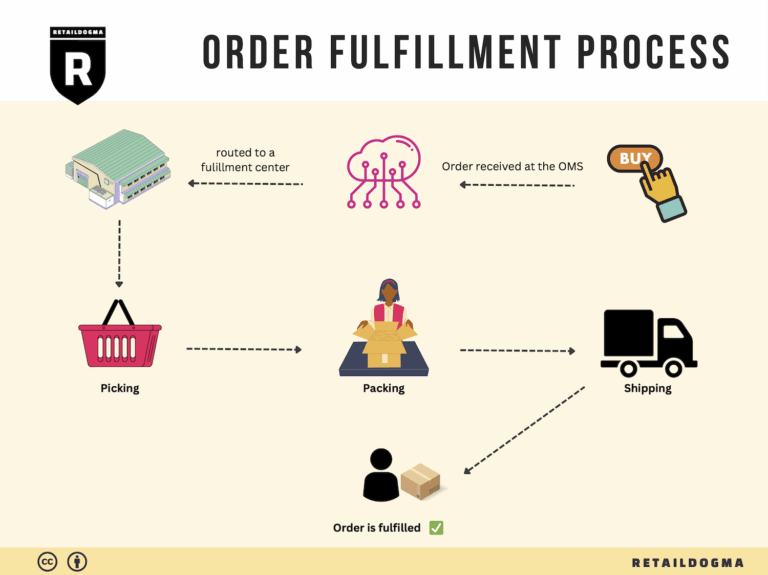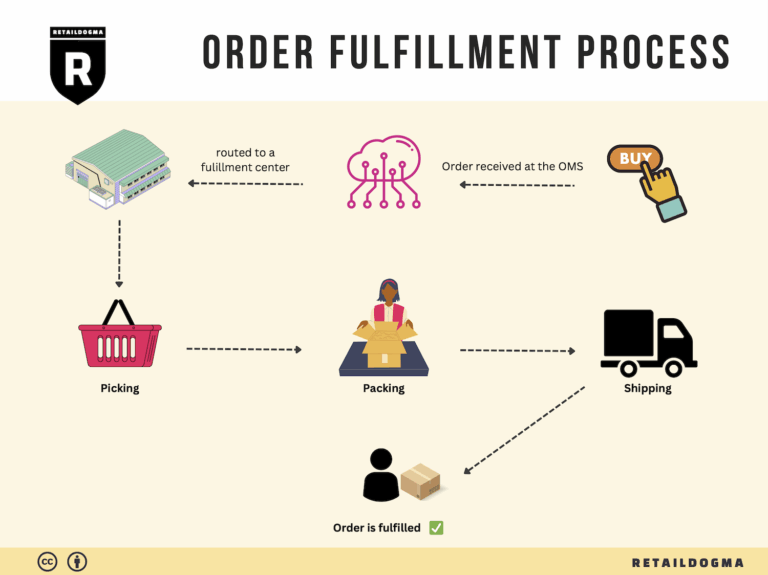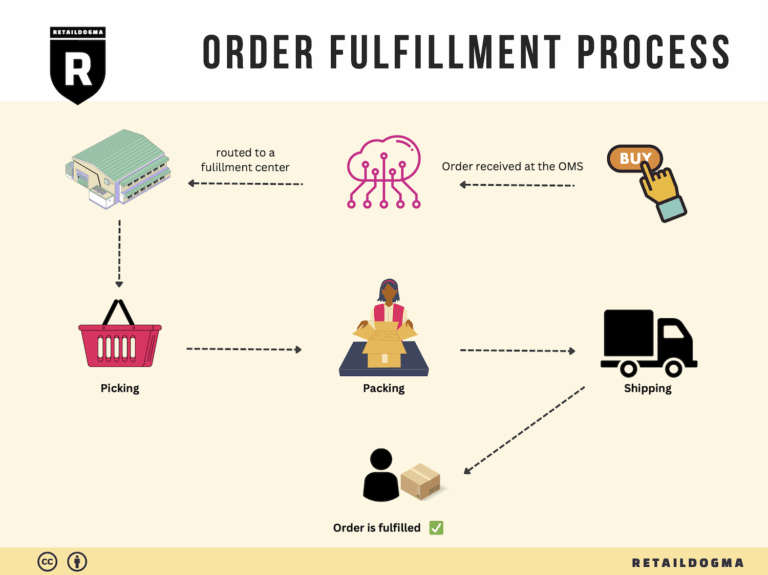How Order Fulfillment Works: A Step-by-Step Guide for Businesses
What is E-commerce Fulfillment? An Introduction for Growing Businesses
Understanding E-commerce Fulfillment: A Key to Scaling Your Business
As an e-commerce business owner, you may often find yourself overwhelmed with the intricacies of packing and shipping orders. The excitement of a growing customer base can quickly turn into stress when faced with the logistics of fulfillment. Ensuring that each order reaches your customers on time and in perfect condition is critical, yet it can feel like an insurmountable task when you’re juggling multiple responsibilities.
At its core, e-commerce fulfillment is the process of getting a product from your inventory to your customer’s doorstep. This encompasses everything from inventory management and order processing to packaging and shipping. As you scale your business, understanding and optimizing this process becomes paramount.
In this guide, we will delve into the various fulfillment models available to online retailers, including Third-Party Logistics (3PL) and Fulfillment by Amazon (FBA). Each model has its strengths and weaknesses, and choosing the right one can significantly impact your operational efficiency and customer satisfaction.
We will also explore the core services that fulfillment partners typically offer. These services can range from warehousing and inventory management to order tracking and returns processing. Understanding these services will help you identify what you need from a fulfillment partner to best support your business model.
Choosing the right fulfillment partner is another critical aspect that we will cover. Factors to consider include their location, technology capabilities, scalability, and customer service. A well-chosen partner can not only streamline your operations but also enhance your customer experience.

Finally, we will discuss pricing structures associated with different fulfillment options. Understanding the costs involved will empower you to make informed decisions that align with your budget and growth objectives.
The goal of this guide is to empower you to make smart, strategic decisions about your logistics. By equipping you with the knowledge of fulfillment models, core services, partner selection, and pricing, you’ll be better prepared to scale your e-commerce business effectively and efficiently. With the right fulfillment strategy in place, you can focus on what you do best: growing your brand and delighting your customers.
What You’ll Learn In This Guide
- What is E-commerce Fulfillment? An Introduction for Growing Businesses
- The Order Fulfillment Process: From ‘Buy’ Button to Customer’s Door
- Comparing Fulfillment Models: In-House vs. 3PL vs. Dropshipping
- A Deep Dive into Amazon FBA: Pros, Cons, and Who It’s For
- Core Services Offered by Fulfillment Centers
- How to Choose a Fulfillment Partner: A 6-Point Checklist
- Understanding Fulfillment Pricing: A Breakdown of Common Fees
- Frequently Asked Questions (FAQs) about Fulfillment
- Conclusion: Is Outsourcing Fulfillment the Right Move for Your Business?
- Important Disclaimer
The Order Fulfillment Process: From ‘Buy’ Button to Customer’s Door
1. Receiving Inventory
The first step in the order fulfillment process is receiving inventory. This involves the physical delivery of products from suppliers to the fulfillment center. Upon arrival, each shipment is checked against purchase orders to ensure accuracy. This step is critical as it lays the groundwork for the entire fulfillment process. If inventory is not received correctly, it can lead to stock discrepancies and order fulfillment errors.
Key Term: SKU (Stock Keeping Unit)
Every product should have a unique SKU that allows for easy tracking and management within the warehouse. This identifier helps in quickly locating items and maintaining accurate inventory levels.
2. Warehouse Storage
Once inventory is received and verified, it is stored in designated areas within the fulfillment center. Efficient storage is vital for optimizing space and ensuring easy accessibility for picking orders. Products are often organized based on categories, sizes, or demand frequency, utilizing methods such as FIFO (First In, First Out) or LIFO (Last In, First Out).
Importance of Storage:
Proper organization can significantly reduce the time it takes to pick items for orders, directly impacting overall efficiency and customer satisfaction. A well-structured storage system also minimizes the risk of damage and loss.
Key Term: Bin Locations
Each item should be assigned a specific bin location within the warehouse, which is essential for streamlined picking operations. This allows staff to quickly find products when orders are processed.
3. Order Picking
After an order is placed, the next step is order picking, where items are selected from storage to fulfill the customer’s order. This process can be done manually or through automated systems, depending on the scale of operations. Efficient picking is critical because it directly influences the speed at which orders can be processed and shipped.
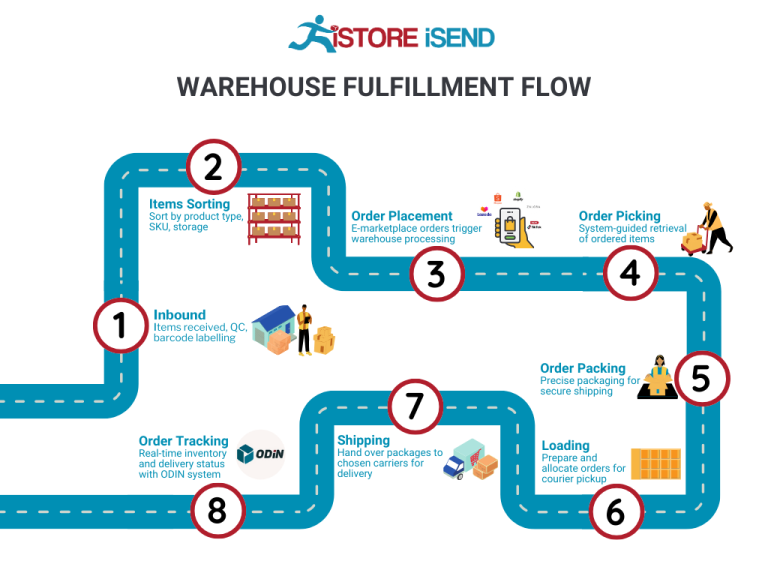
Importance of Picking:
Fast and accurate order picking is essential for maintaining customer satisfaction and meeting delivery timelines. Errors during this stage can lead to incorrect orders being shipped, resulting in returns and diminished customer trust.
Key Term: Pick Lists
A pick list is generated for each order, detailing the items and their respective locations in the warehouse. This document serves as a guide for the picking staff, ensuring all items are accurately collected.
4. Order Packing
Once the items are picked, they move to the packing stage. Here, products are carefully packaged to ensure they arrive safely at the customer’s door. This step involves selecting appropriate packing materials and including any necessary documentation, such as invoices or return labels.
Importance of Packing:
Effective packing is crucial for minimizing damage during transit, which can lead to costly returns and unhappy customers. Additionally, well-packed orders can enhance the unboxing experience, positively influencing customer perception of the brand.
Key Term: Packaging Materials
Using the right packaging materials—such as bubble wrap, boxes, and tape—is essential to protect items during shipping. Businesses should also consider sustainability by opting for eco-friendly materials where possible.
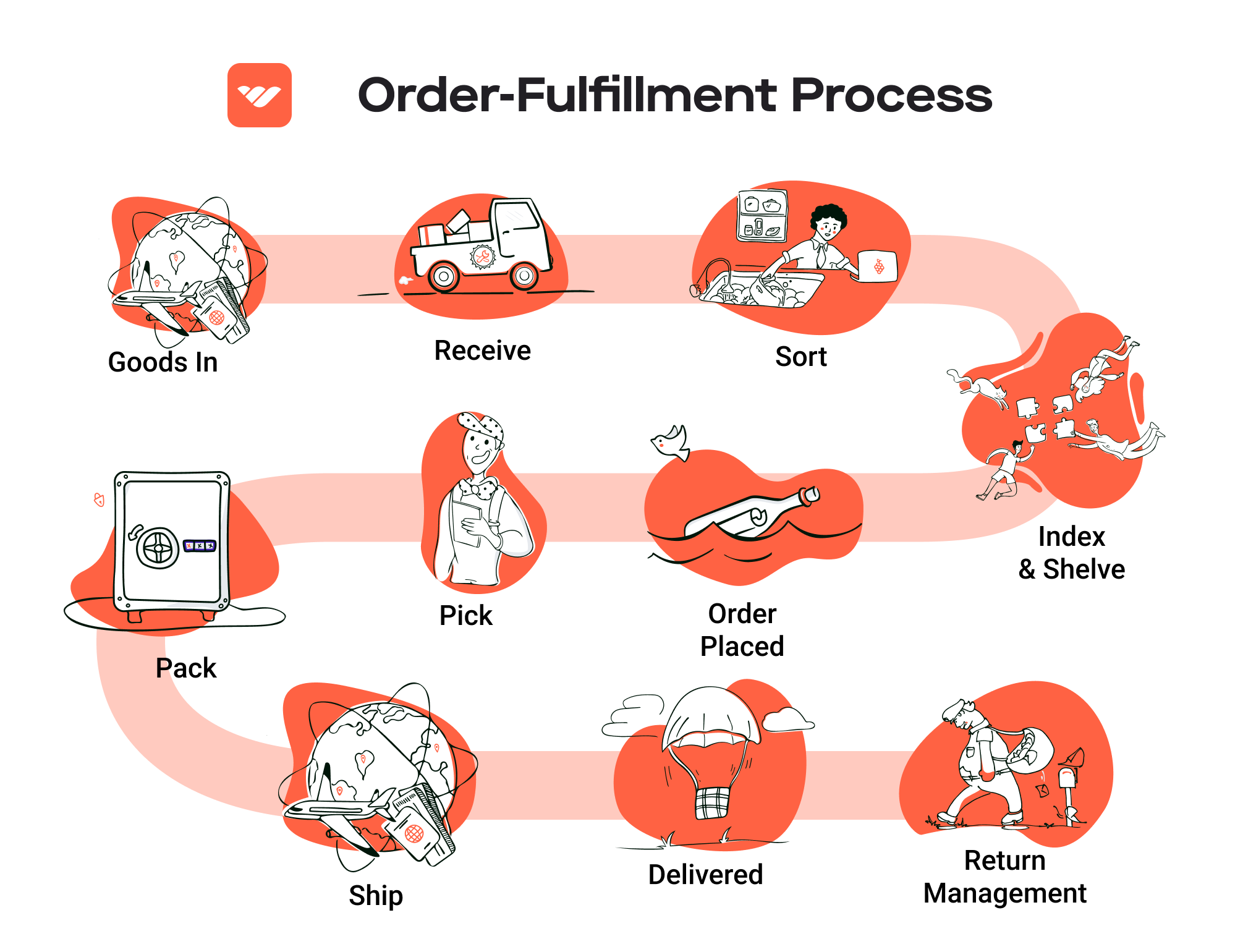
5. Shipping & Delivery
The final step in the order fulfillment process is shipping and delivery. Once packed, orders are labeled and sorted based on their destination. They are then handed over to shipping carriers for transportation. Timely shipping is vital for customer satisfaction and can be a competitive differentiator in e-commerce.
Importance of Shipping:
Efficient shipping practices ensure that orders reach customers promptly, which is increasingly important in today’s fast-paced market. Moreover, providing tracking information enhances the customer experience by keeping them informed about their order status.
Key Term: Last-Mile Delivery
Last-mile delivery refers to the final leg of the shipping process, where packages are delivered from a distribution center to the end customer. This stage is often the most complex and costly, making it essential for businesses to optimize their last-mile logistics to enhance efficiency and reduce costs.
Conclusion
In summary, the order fulfillment process encompasses several critical steps, each playing an integral role in delivering a seamless customer experience. By optimizing each stage—from receiving inventory to shipping and delivery—e-commerce businesses can enhance operational efficiency, reduce costs, and ultimately improve customer satisfaction. Understanding and implementing best practices in these areas is essential for scaling operations and achieving long-term success in the competitive e-commerce landscape.
Comparing Fulfillment Models: In-House vs. 3PL vs. Dropshipping
Fulfillment Model Comparison
| Model | Who Handles Inventory | Best For (Business Stage) | Key Advantage | Key Disadvantage |
|---|---|---|---|---|
| In-House Fulfillment | The business itself | Established businesses with stable sales | Greater control over inventory and quality | High overhead costs and operational complexity |
| Third-Party Logistics (3PL) | A third-party logistics provider | Growing businesses looking to scale | Access to expertise and technology without heavy investment | Less control over inventory and potential communication issues |
| Dropshipping | Suppliers | Startups or small businesses with limited capital | Low upfront costs and minimal risk | Lower profit margins and reliance on supplier reliability |
In-House Fulfillment
In-house fulfillment refers to a model where a business manages its own storage, handling, and shipping of products. This model is ideal for established businesses that have a consistent sales volume, allowing them to maintain control over the entire fulfillment process. One of the significant advantages of in-house fulfillment is the ability to oversee inventory management closely, ensuring quality control and adherence to specific delivery instructions. This level of oversight can enhance customer satisfaction and brand loyalty. However, operating an in-house fulfillment center can come with substantial overhead costs, including warehousing, staffing, and technology investments. Additionally, managing logistics can become operationally complex, especially as the business scales, potentially diverting focus from core activities such as marketing and product development.
Third-Party Logistics (3PL)
Third-party logistics (3PL) involves outsourcing logistics operations to an external service provider. This model is particularly beneficial for growing businesses that are looking to scale without the burden of significant capital investment in logistics infrastructure. A 3PL provider typically offers a suite of services, including warehousing, inventory management, order fulfillment, and shipping. By leveraging a 3PL, businesses can access advanced technology and expertise that may not be feasible to develop in-house. This can lead to improved efficiency and cost-effectiveness. However, a potential downside is the reduced control over inventory, as businesses must rely on the 3PL for timely and accurate fulfillment. Communication issues can also arise, leading to discrepancies in inventory management or order processing, which can affect customer satisfaction if not handled properly.
Dropshipping
Dropshipping is a fulfillment model where a retailer does not keep the products it sells in stock. Instead, when a retailer sells a product, it purchases the item from a third party (typically a wholesaler or manufacturer) and has it shipped directly to the customer. This model is particularly appealing for startups or small businesses with limited capital, as it requires little upfront investment in inventory. The key advantage of dropshipping is the low financial risk, as retailers only pay for products after they have been sold. However, dropshipping comes with its challenges, notably lower profit margins due to reliance on suppliers, who often dictate pricing. Furthermore, the retailer has less control over product quality and shipping times, which can lead to customer dissatisfaction if the supplier fails to meet expectations. As a result, businesses must carefully vet their suppliers and maintain strong relationships to ensure reliability and quality in the fulfillment process.
Conclusion
Choosing the right fulfillment model is crucial for e-commerce businesses looking to scale efficiently. Each model—whether in-house fulfillment, 3PL, or dropshipping—comes with its unique set of advantages and disadvantages. Business owners must assess their current stage, financial capabilities, and long-term goals to determine which model aligns best with their operational needs and customer expectations. By understanding these models, e-commerce businesses can make informed decisions that will enhance their logistics strategy and ultimately drive growth.
A Deep Dive into Amazon FBA: Pros, Cons, and Who It’s For
Understanding Fulfillment by Amazon (FBA)
Fulfillment by Amazon (FBA) is a service offered by Amazon that allows e-commerce sellers to store their products in Amazon’s fulfillment centers. When a customer places an order, Amazon takes care of storage, packaging, shipping, and customer service on behalf of the seller. This service enables sellers to leverage Amazon’s vast logistics network and customer base, making it an attractive option for businesses looking to scale.
How FBA Works
-
Product Listing and Storage: Sellers create product listings on Amazon and send their inventory to Amazon’s fulfillment centers. Once the products arrive, Amazon takes over the responsibility for managing that inventory.
-
Order Processing: When a customer places an order, Amazon picks the product from the warehouse, packs it, and ships it directly to the customer. This process is often automated, allowing for quick processing times.
-
Customer Service and Returns: Amazon handles all customer inquiries and returns, providing a seamless experience for both sellers and buyers. This includes managing refunds and customer feedback.
-
Shipping: Products fulfilled by Amazon are eligible for Amazon Prime, which offers expedited shipping options, enhancing the appeal of the listings.
Pros of Using FBA
1. Prime Eligibility
Products fulfilled through FBA are eligible for Amazon Prime, which can significantly increase visibility and sales. Prime members often prefer to buy products that qualify for fast shipping, and this can lead to higher conversion rates for sellers.
2. Customer Trust
Amazon has built a strong reputation for reliability and customer service. By using FBA, sellers can benefit from this trust, as customers are more likely to purchase items that are backed by Amazon’s customer service and return policies.
3. Multi-Channel Fulfillment
FBA isn’t limited to Amazon sales. Sellers can use FBA to fulfill orders from other sales channels, such as their own websites or other marketplaces. This flexibility allows sellers to centralize their inventory management while still reaching a broader audience.
4. Scalable Operations
FBA allows businesses to scale without needing to invest heavily in logistics and warehousing. As sales increase, sellers can simply send more inventory to Amazon, relying on their infrastructure to handle fulfillment.
5. Time Savings
By outsourcing fulfillment to Amazon, sellers can focus more on other crucial aspects of their business, such as marketing and product development. This can lead to increased productivity and growth.
Cons of Using FBA
1. High Fees
FBA comes with various fees, including storage fees (charged monthly based on the volume of inventory stored) and fulfillment fees (charged per item sold). These costs can add up quickly, particularly for businesses with lower margins or seasonal products.
2. Strict Inventory Rules
Amazon enforces strict policies regarding inventory management. Sellers must adhere to guidelines regarding product packaging, labeling, and inventory limits. Non-compliance can result in additional fees or removal of listings.
3. Commingling Risks
FBA warehouses often commingle inventory from multiple sellers for efficiency. This means that if a product is returned, it may not necessarily come back to the original seller’s inventory. This can lead to issues with counterfeit products or loss of control over product quality.
4. Limited Control Over Fulfillment
Sellers give up a degree of control over how their products are handled and delivered. Issues such as delays in shipping or poor packaging can reflect poorly on the seller, even if they had no direct involvement.
5. Inventory Management Challenges
While FBA can simplify logistics, it also requires careful inventory management. Sellers need to monitor stock levels closely to avoid running out of stock or incurring high storage fees for unsold inventory.
Who is FBA Best For?
Fulfillment by Amazon is particularly well-suited for:
-
Small to Medium-Sized Businesses: Businesses that are growing but lack the infrastructure to manage logistics effectively can benefit from FBA’s streamlined processes.
-
E-commerce Entrepreneurs: New sellers looking to enter the market can leverage Amazon’s established customer base and fulfillment network to gain traction quickly.
-
Brands with High Turnover Products: Sellers with fast-moving consumer goods or seasonal items can benefit from FBA’s efficient fulfillment processes to maximize sales.
-
Businesses Seeking to Scale: Companies looking to expand their reach without investing heavily in logistics can use FBA as a scalable solution.
In conclusion, while Fulfillment by Amazon offers numerous advantages that can help e-commerce businesses thrive, it is essential to weigh these benefits against the potential drawbacks. By understanding both the pros and cons, sellers can make informed decisions that align with their business goals and operational capabilities.
Core Services Offered by Fulfillment Centers
Inventory Management & Warehousing
Inventory management is a critical component of e-commerce operations, and fulfillment centers excel in providing robust solutions for this need. Fulfillment centers, such as those operated by Amazon, offer sophisticated warehousing capabilities that ensure products are stored efficiently, organized systematically, and readily accessible for order fulfillment.
What It Is:
Fulfillment centers utilize advanced inventory management systems that track stock levels, manage reordering processes, and monitor the flow of goods. This includes real-time inventory tracking, automated stock updates, and alerts for low stock levels. Warehousing in fulfillment centers is designed for optimal space utilization, allowing businesses to store a wide variety of products without the overhead costs associated with maintaining a private warehouse.
Benefits:
For e-commerce businesses, effective inventory management provided by fulfillment centers leads to reduced operational costs, improved order accuracy, and enhanced customer satisfaction. By outsourcing warehousing, businesses can scale up or down as needed without the burden of long-term leases or excess inventory. Moreover, real-time visibility into stock levels helps prevent stockouts or overstock situations, enabling businesses to respond swiftly to market demands and optimize their supply chain.
Pick and Pack Services
Pick and pack services are essential for the efficient processing of customer orders. This service involves selecting items from the warehouse (picking) and preparing them for shipment (packing) according to specific customer orders.
What It Is:
Fulfillment centers employ a systematic approach to pick and pack operations, utilizing either manual processes or automated systems to ensure accuracy and speed. Orders are picked according to predefined criteria, such as order priority and item location, and are then packed securely to prevent damage during transit. Many fulfillment centers also offer custom packing options, including branded packaging, gift wrapping, and specialized packing materials for fragile items.
Benefits:
The primary advantage of pick and pack services is the reduction in order processing time, which directly impacts shipping speed and customer satisfaction. By leveraging fulfillment centers, e-commerce businesses can benefit from the expertise of trained staff who are adept at optimizing picking routes and packing methods, thereby minimizing errors and enhancing the overall customer experience. Additionally, as order volumes fluctuate, businesses can scale their pick and pack operations without the need for additional labor or infrastructure investment.
Kitting and Assembly
Kitting and assembly services involve combining multiple products into a single package or kit, which is particularly beneficial for businesses offering bundled products or promotional items.
What It Is:
This service includes the assembly of items into a kit, which could range from simple product bundles to complex multi-component products. Fulfillment centers have the necessary equipment and skilled labor to perform kitting tasks efficiently, ensuring that each kit meets the specific requirements of the business and its customers.
Benefits:
Kitting can significantly streamline the fulfillment process by reducing the number of SKUs (Stock Keeping Units) that need to be managed and shipped individually. This not only simplifies inventory management but also enhances the customer experience by providing ready-to-ship products. For businesses, kitting allows for creative marketing strategies, such as offering themed bundles or promotional packages, which can drive sales and improve customer engagement. Moreover, outsourcing kitting to a fulfillment center saves time and resources, allowing businesses to focus on core activities such as marketing and product development.
Returns Management (Reverse Logistics)
Returns management is a critical aspect of e-commerce operations, particularly given the increasing importance of customer satisfaction and retention.
What It Is:
Fulfillment centers provide comprehensive returns management services that handle the entire reverse logistics process. This includes receiving returned items, inspecting their condition, restocking items that are in sellable condition, and managing the disposal of damaged goods. Fulfillment centers often implement automated systems to streamline returns processing, ensuring that returns are handled quickly and efficiently.
Benefits:
Effective returns management offered by fulfillment centers is vital for maintaining customer trust and loyalty. By providing a hassle-free returns process, businesses can enhance customer satisfaction and encourage repeat purchases. Additionally, efficient handling of returns helps businesses recover value from returned items through restocking or refurbishment, ultimately contributing to overall profitability. Furthermore, the data collected from returns can provide valuable insights into customer preferences and product performance, enabling businesses to make informed decisions about inventory and product offerings.
In conclusion, partnering with a fulfillment center can provide e-commerce businesses with a range of core services that streamline operations, enhance customer satisfaction, and ultimately support scalable growth. By leveraging the expertise and infrastructure of fulfillment centers, businesses can focus on strategic initiatives while ensuring that their logistics and supply chain operations run smoothly.
How to Choose a Fulfillment Partner: A 6-Point Checklist
Location & Warehouse Network
Why It’s Important:
The geographical location of your fulfillment partner can significantly affect shipping costs and delivery times. A partner with strategically located warehouses can ensure faster delivery to your customers and lower shipping expenses.
Questions to Ask:
– Where are your warehouses located, and how do these locations align with my customer base?
– Do you have a network of warehouses that can facilitate same-day or next-day delivery?
– What transportation options do you utilize for shipping, and how do they impact delivery speed and cost?
Technology & Integrations
Why It’s Important:
A fulfillment partner’s technology stack can either streamline your operations or create bottlenecks. Robust technology solutions enable seamless integration with your e-commerce platform, providing real-time inventory updates, order tracking, and data analytics.
Questions to Ask:
– What software do you use for inventory management, and how does it integrate with my existing systems?
– Do you offer APIs or plugins for popular e-commerce platforms like Shopify, WooCommerce, or Amazon?
– How do you handle order tracking, and can customers access this information easily?
Specializations (e.g., Cold Storage, Oversized Items)
Why It’s Important:
Different businesses have unique fulfillment needs. Whether you deal in perishable goods, oversized items, or require specialized handling, choosing a partner with the right capabilities is crucial for maintaining product integrity and customer satisfaction.
Questions to Ask:
– Do you have experience handling the specific types of products I sell (e.g., perishables, bulky items)?
– What specialized equipment or processes do you have in place for these items?
– Can you provide examples of how you have successfully managed similar products for other clients?
Scalability & Capacity
Why It’s Important:
As your business grows, your fulfillment needs will evolve. A partner that can scale alongside you ensures that you won’t face operational hiccups during peak seasons or as your sales increase.
Questions to Ask:
– How do you handle seasonal fluctuations in order volume?
– What is your current capacity, and how quickly can you scale operations if my sales increase significantly?
– Can you provide references from clients who have scaled their operations with your support?
Pricing and Contracts
Why It’s Important:
Understanding the pricing structure and contract terms is essential for budgeting and financial planning. Hidden fees can erode profit margins, so clarity is key.
Questions to Ask:
– What is your pricing model (e.g., per order, per item, storage fees)?
– Are there any hidden fees or additional costs I should be aware of?
– What are the terms of your contract, and are there any penalties for early termination or scaling down?
Customer Support & Reviews
Why It’s Important:
Reliable customer support can make a significant difference in your experience with a fulfillment partner. Quick response times and effective problem-solving capabilities can prevent small issues from escalating into major disruptions.
Questions to Ask:
– What level of customer support do you provide (e.g., dedicated account manager, 24/7 support)?
– How do you handle issues such as order errors or shipping delays?
– Can you provide testimonials or case studies from other clients that highlight your customer service quality?
Conclusion
Choosing the right fulfillment partner is a critical decision for any e-commerce business looking to scale. By using this checklist, you can systematically evaluate potential partners and ensure they align with your operational needs and growth objectives. Remember that the right partner will not only fulfill your orders but also support your overall business strategy.
Understanding Fulfillment Pricing: A Breakdown of Common Fees
Initial Setup Fees
When partnering with a fulfillment center, the initial setup fees are often the first costs you will encounter. These fees can vary significantly depending on the complexity of your e-commerce operation and the specific services you require. Generally, setup fees cover the costs associated with onboarding your business into the fulfillment system. This may include the creation of your account, integration of your inventory management system, and initial training for your staff on how to work with the fulfillment center.
Initial setup fees are typically a one-time expense but can range from a few hundred to several thousand dollars, depending on the level of customization and support needed. To minimize these costs, it’s advisable to have your inventory organized and well-documented before beginning the onboarding process. This preparation can streamline the setup, potentially reducing fees.
Receiving Fees
Receiving fees are charged by fulfillment centers for the process of accepting your inventory. This involves inspecting, counting, and entering your products into the warehouse management system. These fees are typically calculated on a per-unit basis and may vary based on the size and weight of the items being received.
For example, a fulfillment center may charge $0.20 per item for standard-size products and higher rates for oversized or specialty items. Understanding the receiving fees is crucial as they can add up quickly, especially for businesses that frequently replenish their inventory. To keep these fees in check, consider consolidating shipments whenever possible or negotiating bulk receiving rates with your fulfillment partner.
Storage Fees (per pallet/bin)
Storage fees are incurred for the space your inventory occupies within the fulfillment center. These fees can be assessed on a per-pallet or per-bin basis and are generally calculated monthly. The cost will depend on several factors, including the type of storage required (standard vs. climate-controlled) and the overall volume of inventory.
For instance, storage fees might range from $15 to $30 per pallet per month. If your business has seasonal fluctuations, it’s wise to monitor your inventory turnover rates to avoid unnecessary storage costs. Consider implementing a just-in-time inventory strategy to minimize storage fees, ensuring that you only keep what you need on hand.
Pick & Pack Fees (per item/order)
Pick and pack fees are charged for the process of selecting items from inventory and packaging them for shipment. This is a critical aspect of fulfillment, as it directly impacts your order fulfillment speed and accuracy. Fees are typically calculated per item or per order, depending on how the fulfillment center structures its pricing.
For example, a center may charge $1.00 to pick and pack an order containing three items, or $0.50 per item if you have a larger order. This fee can vary based on the complexity of the packing process (e.g., special packaging or kitting). To optimize pick and pack fees, consider streamlining your product offerings or negotiating a tiered pricing structure based on your order volume.
Shipping Fees
Shipping fees are one of the most significant costs associated with fulfillment. These fees cover the cost of transporting your products from the fulfillment center to your customers. Shipping fees can vary based on several factors, including package weight, dimensions, destination, and shipping method (e.g., standard, expedited).
Most fulfillment centers offer discounted shipping rates through partnerships with major carriers, which can help reduce overall shipping costs. It’s essential to understand how shipping fees are calculated, as they can significantly impact your profit margins. To minimize shipping costs, consider using a multi-carrier shipping strategy, allowing you to select the most cost-effective option for each shipment.
Tips for Getting an Accurate Quote
-
Understand Your Needs: Before requesting quotes, have a clear understanding of your inventory levels, order volumes, and specific fulfillment requirements. This will help fulfillment centers provide a more accurate estimate.
-
Request Detailed Breakdowns: Ask potential partners for detailed pricing breakdowns, including all potential fees. This transparency will help you compare different fulfillment centers more effectively.
-
Negotiate Rates: Don’t hesitate to negotiate rates based on your projected order volume. Many fulfillment centers are willing to offer discounts for long-term partnerships or higher volumes.
-
Consider Hidden Fees: Be aware of any additional fees that may not be immediately apparent, such as returns processing or inventory management fees. Clarifying these upfront can prevent surprises later.
-
Review Service Levels: Finally, ensure that the service levels offered align with your business needs. Sometimes, the cheapest option may not provide the reliability or speed required to meet customer expectations.
By carefully considering these factors and preparing adequately, you can make informed decisions that align with your e-commerce growth strategy.
Frequently Asked Questions (FAQs) about Fulfillment
1. What is an Amazon Fulfillment Center?
An Amazon Fulfillment Center is a large warehouse where Amazon stores products and processes orders. When a customer places an order, the fulfillment center picks, packs, and ships the items directly to the customer. The centers are designed to optimize logistics and delivery speed, playing a crucial role in Amazon’s ability to provide rapid shipping options.
2. What is the role of the SAZ1/HPX1/VAZ1 Fulfillment Center in Phoenix, AZ?
The SAZ1/HPX1/VAZ1 Fulfillment Center in Phoenix serves as a key logistics hub for Amazon, facilitating the efficient handling of inventory and order fulfillment for customers in the region. Its strategic location near major transportation routes, such as the I-10 freeway, enhances its capability to manage high volumes of shipments and deliveries.
3. How do I track my orders fulfilled by this center?
To track orders fulfilled by the SAZ1/HPX1/VAZ1 center, you can use the tracking number provided in your order confirmation email. This number can be entered on the Amazon website or app to see the status of your shipment, including its current location and estimated delivery date.
4. What is the difference between a warehouse and a fulfillment center?
While both warehouses and fulfillment centers store products, their purposes differ significantly. A warehouse is primarily used for storage, often for long-term inventory management, while a fulfillment center is focused on processing orders for immediate shipping. Fulfillment centers employ advanced technology and logistics processes to ensure quick turnaround times for order delivery.
5. What is a 3PL (Third-Party Logistics)?
A 3PL, or Third-Party Logistics provider, is a service that allows businesses to outsource their logistics operations, including warehousing, order fulfillment, and shipping. Partnering with a 3PL can help e-commerce businesses scale their operations by leveraging the provider’s expertise, technology, and distribution networks.
6. How much do fulfillment services cost?
The cost of fulfillment services varies widely based on several factors, including the volume of orders, the type of products being shipped, and the specific services required (such as storage, packing, and shipping). Typically, businesses can expect to pay per order, as well as monthly fees for storage and additional services. It’s advisable to request quotes from multiple providers to compare costs.
7. What are the operating hours of the SAZ1/HPX1/VAZ1 Fulfillment Center?
The SAZ1/HPX1/VAZ1 Fulfillment Center operates from 3 AM to 11 PM, seven days a week. It’s essential for employees and delivery drivers to be aware of these hours to avoid delays in their operations.
8. What should I do if my package is delivered damaged or incorrectly?
If your package is delivered damaged or the wrong item is received, you should immediately report the issue to Amazon through your account. Use the “Your Orders” section to initiate a return or replacement. Amazon typically has a straightforward process for handling such issues, which may include issuing a refund or sending a replacement item.
9. How can I improve my delivery experience with Amazon Fulfillment Centers?
To enhance your delivery experience, ensure that your delivery instructions are clear and specific. Monitor your order status closely, and if you encounter issues with delivery (like missed instructions), provide feedback to Amazon. Additionally, being proactive about tracking your packages can help you stay informed about their status.
10. Are there any specific challenges associated with the SAZ1/HPX1/VAZ1 Fulfillment Center?
While the SAZ1/HPX1/VAZ1 Fulfillment Center is designed for efficiency, it has faced criticism regarding delivery mishaps, parking issues, and staff responsiveness. To mitigate these challenges, it is advisable to arrive early for pickups or deliveries, remain vigilant about tracking your orders, and communicate any specific delivery needs clearly.
Conclusion: Is Outsourcing Fulfillment the Right Move for Your Business?
Evaluating the Benefits of Outsourcing Fulfillment
Outsourcing fulfillment can be a transformative decision for your e-commerce business, offering several key benefits that can significantly enhance your operations. First and foremost, it saves time. By delegating logistics to a fulfillment partner, you can focus on core business activities such as product development, marketing, and customer engagement. This shift allows you to allocate resources more efficiently and enhances overall productivity.
Another critical advantage is scalability. As your business grows, so do your logistics needs. A reliable fulfillment service can seamlessly adjust to increased order volumes without the need for extensive investments in infrastructure or staffing. This flexibility ensures that you can meet demand spikes during peak seasons or promotional campaigns, all while maintaining a high level of service quality.
Moreover, partnering with an experienced fulfillment provider brings specialized expertise to your operations. These partners are well-versed in the nuances of shipping, warehousing, and inventory management. They can optimize your supply chain processes, minimize errors, and improve delivery times, which in turn enhances customer satisfaction and loyalty.
However, the success of outsourcing fulfillment heavily relies on choosing the right partner. Conducting thorough research and evaluating potential providers based on their track record, technology capabilities, and customer service is essential.
Take Action Today
To determine if outsourcing fulfillment is the right move for your business, start by auditing your current shipping processes. Identify pain points, inefficiencies, and areas where you could benefit from external expertise. This analysis will provide you with a clearer picture of your needs and help you make an informed decision about whether a fulfillment partner can support your growth ambitions. Embrace the opportunity to scale your operations and enhance your customer experience—your future self will thank you.
Important Disclaimer
⚠️ Important Disclaimer
The information in this guide is for educational purposes. Fulfillment services, pricing, and platform features change frequently. Always conduct your own due diligence and consult with providers directly before making business decisions.
